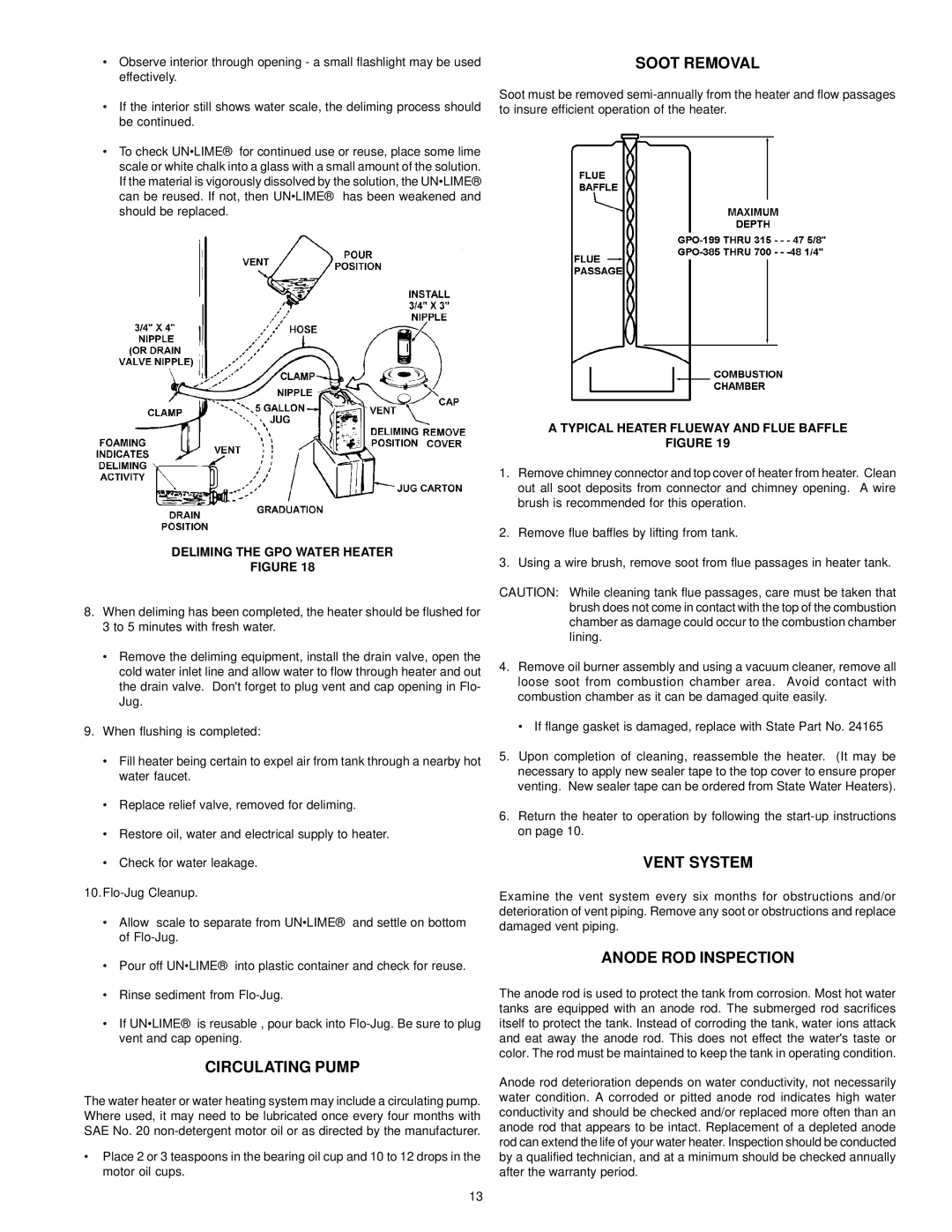
•Observe interior through opening - a small flashlight may be used effectively.
•If the interior still shows water scale, the deliming process should be continued.
•To check UN•LIME® for continued use or reuse, place some lime scale or white chalk into a glass with a small amount of the solution. If the material is vigorously dissolved by the solution, the UN•LIME® can be reused. If not, then UN•LIME® has been weakened and should be replaced.
DELIMING THE GPO WATER HEATER
FIGURE 18
8.When deliming has been completed, the heater should be flushed for 3 to 5 minutes with fresh water.
•Remove the deliming equipment, install the drain valve, open the cold water inlet line and allow water to flow through heater and out the drain valve. Don't forget to plug vent and cap opening in Flo- Jug.
9.When flushing is completed:
•Fill heater being certain to expel air from tank through a nearby hot water faucet.
•Replace relief valve, removed for deliming.
•Restore oil, water and electrical supply to heater.
•Check for water leakage.
10.
•Allow scale to separate from UN•LIME® and settle on bottom of
•Pour off UN•LIME® into plastic container and check for reuse.
•Rinse sediment from
•If UN•LIME® is reusable , pour back into
CIRCULATING PUMP
The water heater or water heating system may include a circulating pump. Where used, it may need to be lubricated once every four months with SAE No. 20
•Place 2 or 3 teaspoons in the bearing oil cup and 10 to 12 drops in the motor oil cups.
SOOT REMOVAL
Soot must be removed
A TYPICAL HEATER FLUEWAY AND FLUE BAFFLE
FIGURE 19
1.Remove chimney connector and top cover of heater from heater. Clean out all soot deposits from connector and chimney opening. A wire brush is recommended for this operation.
2.Remove flue baffles by lifting from tank.
3.Using a wire brush, remove soot from flue passages in heater tank.
CAUTION: While cleaning tank flue passages, care must be taken that brush does not come in contact with the top of the combustion chamber as damage could occur to the combustion chamber lining.
4.Remove oil burner assembly and using a vacuum cleaner, remove all loose soot from combustion chamber area. Avoid contact with combustion chamber as it can be damaged quite easily.
• If flange gasket is damaged, replace with State Part No. 24165
5.Upon completion of cleaning, reassemble the heater. (It may be necessary to apply new sealer tape to the top cover to ensure proper venting. New sealer tape can be ordered from State Water Heaters).
6.Return the heater to operation by following the
VENT SYSTEM
Examine the vent system every six months for obstructions and/or deterioration of vent piping. Remove any soot or obstructions and replace damaged vent piping.
ANODE ROD INSPECTION
The anode rod is used to protect the tank from corrosion. Most hot water tanks are equipped with an anode rod. The submerged rod sacrifices itself to protect the tank. Instead of corroding the tank, water ions attack and eat away the anode rod. This does not effect the water's taste or color. The rod must be maintained to keep the tank in operating condition.
Anode rod deterioration depends on water conductivity, not necessarily water condition. A corroded or pitted anode rod indicates high water conductivity and should be checked and/or replaced more often than an anode rod that appears to be intact. Replacement of a depleted anode rod can extend the life of your water heater. Inspection should be conducted by a qualified technician, and at a minimum should be checked annually after the warranty period.
13
